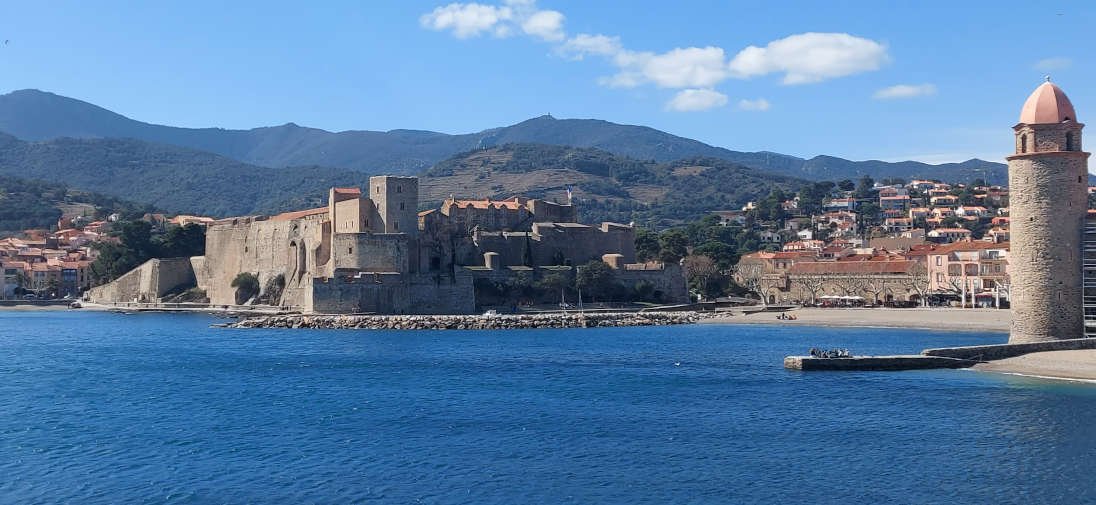
Collioure - between mountain and sea
Jewel of the Eastern Pyrenees
About-France.com
- the connoisseur's guide to France
Collioure - France's favourite small town
| On this page | Location and access | Old Collioure |
| In the area | Stay in Collioure ► |
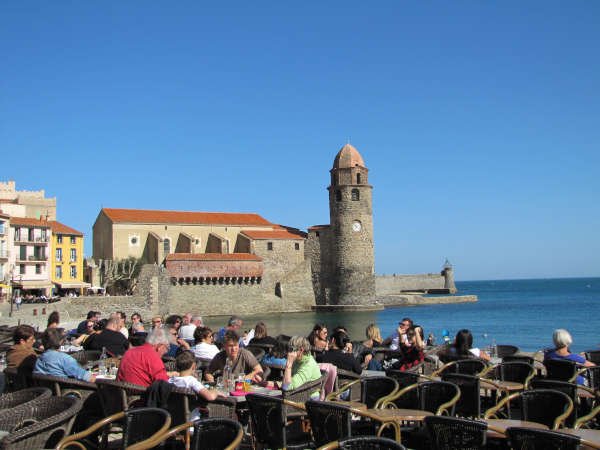
A February morning in Collioure
Long before France was defined by the borders we know today, Collioure was part of the kingdom of Aragon, which extended either side of what is now the international border between France and Spain. The site was a useful natural harbour, sheltered from the north winds, and protected since the early Middle Ages by an imposing castle, first established under Guifred, Count of Roussillon, in the late tenth century.
Throughout the Middle Ages, territories around the Pyrenees were the subject of numerous conflicts between kingdoms and counties to the north, areas that are now in France, and kingdoms to the south, which are now part of Spain; and for many centuries, Aragon and Catalonia and Navarre occupied territory on both sides of the Pyrenees. With its strategic seaside location, Collioure was an important bastion.
After 1659, when the Treaty of the Pyrenees established the modern-day border between France and Spain, Collioure's strategic importance became that of a frontier garrison, protecting France from any potential incursion from the south; but barring a short interlude in 1793-94 when the Spanish briefly took Collioure during the War of the Pyrenees, the town's history has been largely peaceful.
In 1864 – long before the birth of modern tourism – the railway reached Collioure, making the town accessible from Perpignan and places far beyond; but Collioure did not grow significantly; the town's harbour was too shallow for larger 19th century vessels, and commercial activity moved to the deeper creek just to the south, at Port Vendres. It was in the late 19th century, as tourism slowly began to develop, that artists in search of the bright light and colours of the Mediterranean began visiting Collioure, painting its old sea front , its harbour and hillsides. First to come was the pointilliste post-Impressionist Paul Signac who first "discovered" Collioure in 1888; over the coming years, the town attracted many more artists, including Marquet, Picasso, Braque, Matisse, Chagall, and the Scotland's Charles Rennie Mackintosh.
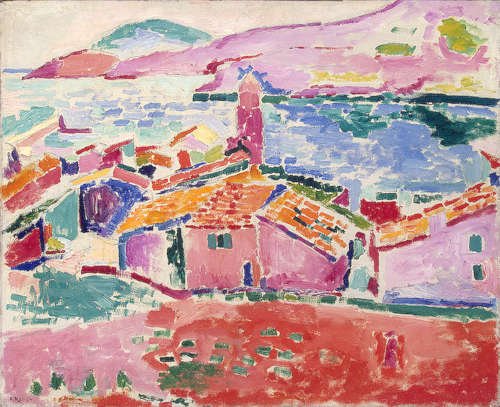
Collioure, by Matisse
Standing beside the Mediterranean in the most southerly part of continental France, Collioure enjoys a temperate climate, and attracts visitors at all times of the year. Naturally, the town is particularly busy in July and August. In 2024, Collioure was voted France's favourite small town.
To see in Collioure
- Royal Fortress. (35 km) Built up between the Middle Ages and the 17th century, this impressive fortress houses a museum
- Notre-Dame-des-Anges church. Standing litterally at the water's edge, beside the harbour, this 17th century church, with its baroque interior, is Collioure's iconic landmark .
- The old town and harbour. The town is built round the harbour, its narrow streets bordered by arts and crafts shops, cafés and restaurants. Boat trips and fishing trips are available from the harbour.
- The Museum of Modern Art On the south side of the harbout, the Modern Art museum houses a colection of 20th century art from artists associated with Collioure. Closed Tuesdays.
- St. Elme Fortress. On a hill high above the town, this fortress, accessible by car or on foot, offers panoramic views down onto the town, and along the coast to the north.
- Collioure windmill - An old windmill that has been recently restored as a working olive oil press. Access is up the hill on foot, from beside the Museum of Modern Art.

Stunning eleventh century sculpture in the Romanesque cloisters of the cathedral at Elne
- Elne -15 km - One of those small French towns that the guide books seem to have failed to notice, Elne, once an important city, has a small cathedral with one of the finest and largest romanesque cloisters in France.
- Port Vendres - 3 km - the next small port, south of Collioure, has fishing boats and a small commercial port specialised in fruit
- The Costa Brava The northern part of Spain's Costa Brava can be easily reached by car, over a twisting coastal road, and even by train, with a change at the historic frontier station of Port Bou (30 km)..
- Céret - 35 km. Deslightful small town with impressive Museum of Modern Art, with works by Picasso, Chagall, Matisse and many others. Market on Saturdays.
- Figueres (Spain) - 60 km. Very popular Salvador Dali museum, in the town where the artist was born and died.
- Massif des Albères. The Massif des Albères, form the eastern end of the frontier between France and Spain, and provide plenty of opportunities for hiking in the hills behind Collioure
- Saint Cyprien - 15 km. Over 100 years old, the Capellans Botanical Garden (Jardin des plantes de Capellan) is A 5 hectare botanical garden, with over 500 species, including a unique collection of palm trees and a large bamboo grove.
- The vineyards of Banyuls. - 12 km. The village of Banyuls produces a distinctive aperitif wine, from remarkable steep stony terraced vineyards on the slopes of the mountains exposed to the Mediterranean.
- By air The nearest airports are at Perpignan in France and Girona (well served by low cost airlines) in Spain.
- By train There are direct daily TGV high-speed train services to Perpignan from Paris, Toulouse, Marseilles and Barcelona. From Montpellier or Perpignan train station connect to the local TER train which stops close to the old town
- By car Collioure is a short distance from the A9 (Paris -) Montpellier - Spain motorway. Leave at Exit 43 signposted Le Boulou, and follow D618 to Argelès, then D914.
Copyright
© About-France.com except where otherwise stated.
About-France.com
Home
page - Site
search
- Regions
- Maps of France
- Contact
Photo top of page : Collioure, from the mouth
of the harbour
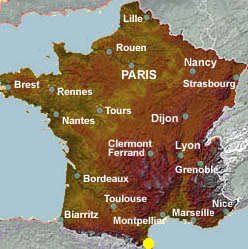
★★ Hôtel des Templiers
Small artistic two-star hotel in the old town. Much in demand.
★★★ Hôtel le Bon Port
Three star hotel with parking and rooms with a view. Restaurants close by
★★★★ Hôtel les Roches Brunes
Offers the perfect hotel experience in Collioure. Quiet, beside the sea, 18 rooms, free parking.
Lots more hotels, B&Bs & apartments in and around Collioure
A choice of Saint-Emilion accommodation from Booking.com
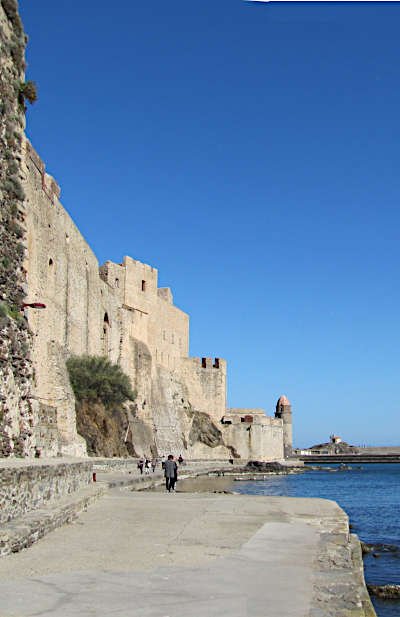
Walkway at the foot of the fortress
Map from Openstreetmap. org
Key
tourist information for Collioure :
Region: Occitanie - Area: Roussillon
Nearby cities: Perpignan
Nearest airports: Perpignan (30 minutes by car)
Population: 2500
Nearby attractions and sites: The Eastern Pyrenees, the coast, Spanish Catalonia,
Region: Occitanie - Area: Roussillon
Nearby cities: Perpignan
Nearest airports: Perpignan (30 minutes by car)
Population: 2500
Nearby attractions and sites: The Eastern Pyrenees, the coast, Spanish Catalonia,

Where to stay in Collioure
The
About-France.com selection
Hotels for all budgets and all needs
Hotels for all budgets and all needs
★★ Hôtel des Templiers
Small artistic two-star hotel in the old town. Much in demand.
★★★ Hôtel le Bon Port
Three star hotel with parking and rooms with a view. Restaurants close by
★★★★ Hôtel les Roches Brunes
Offers the perfect hotel experience in Collioure. Quiet, beside the sea, 18 rooms, free parking.
Lots more hotels, B&Bs & apartments in and around Collioure
A choice of Saint-Emilion accommodation from Booking.com

Walkway at the foot of the fortress
| ►► Site guide |
| About-France.com home |
| Full site index |
| About-France.com site search |
| ►► Principal chapters on About-France.com |
| The
regions of France Beyond
Paris, a guide to the French regions and their tourist attractions.
|
| Accommodation
in France |
| Guide
to Paris Make
the most of your trip to Paris; attractions,
Paris hotels,
transport, and lots more.
|
| Tourism in France
The
main tourist attractions and places to visit in France - historic
monuments, art galleries, and more
|
| Planning
a trip to
France
Information
on things to do before starting your trip to France.
|
| Driving
in France
Tips
and useful information on driving in and through France - motorways,
tolls, where to stay....
|
| Maps
of France
Cities,
towns, departments, regions, climate, wine areas and other themes.
|
| The French way of
life
A
mine of information about life and living in France,
|
| A-Z
dictionary
of France Encyclopedic
dictionary of modern France
|
Click here for
low-cost car hire in France
Copyright texts and photos
©
About-France.com 2007 - 2025 low-cost car hire in France
Map from Openstreetmap. org
